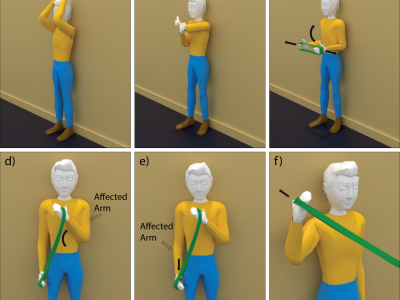Shoulder Physiotherapy Activity Recognition 9-Axis Dataset

- Citation Author(s):
-
David Burns (University of Toronto Department of Surgery, Division of Orthopaedic Surgery)Cari Whyne (Sunnybrook Research Institute, Orthopaedic Biomechanics Lab, Holland Bone and Joint Program)
- Submitted by:
- Philip Boyer
- Last updated:
- DOI:
- 10.21227/cx5v-vw46
- Data Format:
 1944 views
1944 views
- Categories:
- Keywords:
Abstract
Suggested uses of this dataset include performing supervised classification analysis of physiotherapy exercises, or to perform out-of-distribution detection analysis with unlabeled activities of daily living data.
Description:
This dataset contains inertial data consisting of 1) physiotherapy exercise recordings, and 2) unlabeled other activity data recordings, each collected by Huawei 2 smart watches worn by healthy subjects. Subjects peform 20 repetitions of each exercise for each shoulder. Isometric exercises are kept under tension for several seconds per repetition without movement during or between repetitions.
Unlabelled activities of daily living were performed by subjects without supervision. Approximately 3 hours of other activity data were collected per subject. Note that non-exercise data that was captured between exercises has been removed.
Hint: There is a much greater amount of other activity data than exercise data, so depending on your purpose you may need to do some balancing.
Instructions:
(Please note that this dataset is currently only available in individual csv files for each subject as we are having difficulties uploading zipped folders. We have reached out to IEEEDataport to help us resolve this issue)
This dataset consists of 20 csv files, one for each of the subjects in the dataset (e.g. "spars9x_s0.csv" corresponds to the first subject of the dataset). These are contained in the zip file spars9xcsv.zip.
We have also provided the dataset in a numpy array format (spars9xnpy.zip), consisting of a single array and 20 subarrays, one for each dataset subject. These may be loaded into memory using the load() function of the python library numpy.
Either file needs to be decompressed (unzipped) before use.
Data Labels:
0: Unlabeled Activities of Daily Living (Non-Exercise)
1: External Rotation (Isometric)
2: External Rotation in 90 Degrees Abduction in Scapula Plane
3: Internal Rotation (Isometric)
4: Extension (Isometric)
5: Abduction (Isometric)
6: Biceps Muscle Strengthening
7: Cross Chest Adduction
8: Active Flexion
9: Shoulder Girdle Stabilization with Elevation
10: Triceps Pull Downs
Data Format:
Inertial data and heart rate have been interpolated to 50 Hz (inertial sensor acquisition was approximately 50 Hz, but sensors recorded asynchronously and so interpolation was needed).
Each record consists of an Nx12 array, where numbered columns correspond to:
0-2: Accelerometer (X/Y/Z) in m/s^2
3-5: Magnetometer (X/Y/Z) in μT's
6-8: Gyroscope (X/Y/Z) in rad/s
9: Heart Rate in bpm
10: Shoulder (0 = Unlabeled, 1 = Left Shoulder, 2 = Right Shoulder)
11: Activity Label (0-10 as described above)
Note: All exercise data has left or right shoulder indicated, whereas other activity data does not. Other activity data may be assigned to left or right shoulder for analysis, or split between each as required.
Citation Request:
If using this data in academic publication, please cite the following manuscript:
Boyer, P.; Burns, D.; Whyne, C. Out-of-Distribution Detection of Human Activity Recognition with Smartwatch Inertial Sensors. Sensors 2021, 21, x. https://doi.org/10.3390/xxxxx
Dataset Files
- SPARS9x subject 0 data (Size: 264.17 MB)
- SPARS9x subject 1 data (Size: 392.87 MB)
- SPARS9x subject 2 data (Size: 396.7 MB)
- SPARS9x subject 3 data (Size: 185.72 MB)
- SPARS9x subject 4 data (Size: 343.43 MB)
- SPARS9x subject 5 data (Size: 466.66 MB)
- SPARS9x subject 6 data (Size: 461.94 MB)
- SPARS9x subject 7 data (Size: 487.7 MB)
- SPARS9x subject 8 data (Size: 487.85 MB)
- SPARS9x subject 9 data (Size: 193.55 MB)
- SPARS9x subject 10 data (Size: 205.27 MB)
- SPARS9x subject 11 data (Size: 204.32 MB)
- SPARS9x subject 12 data (Size: 302.84 MB)
- SPARS9x subject 13 data (Size: 340.39 MB)
- SPARS9x subject 14 data (Size: 341.23 MB)
- SPARS9x subject 15 data (Size: 180.05 MB)
- SPARS9x subject 16 data (Size: 510.86 MB)
- SPARS9x subject 17 data (Size: 76.89 MB)
- SPARS9x subject 18 data (Size: 399.22 MB)
- SPARS9x subject 19 data (Size: 404.07 MB)







